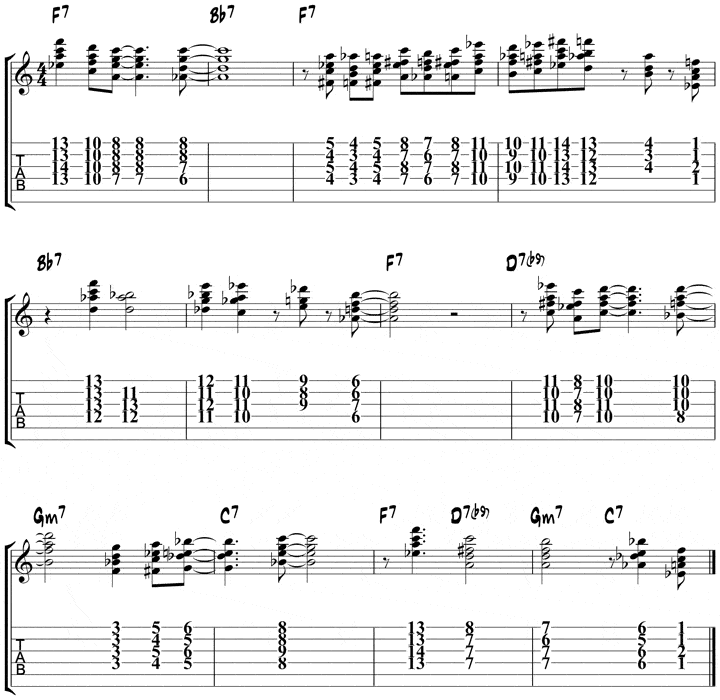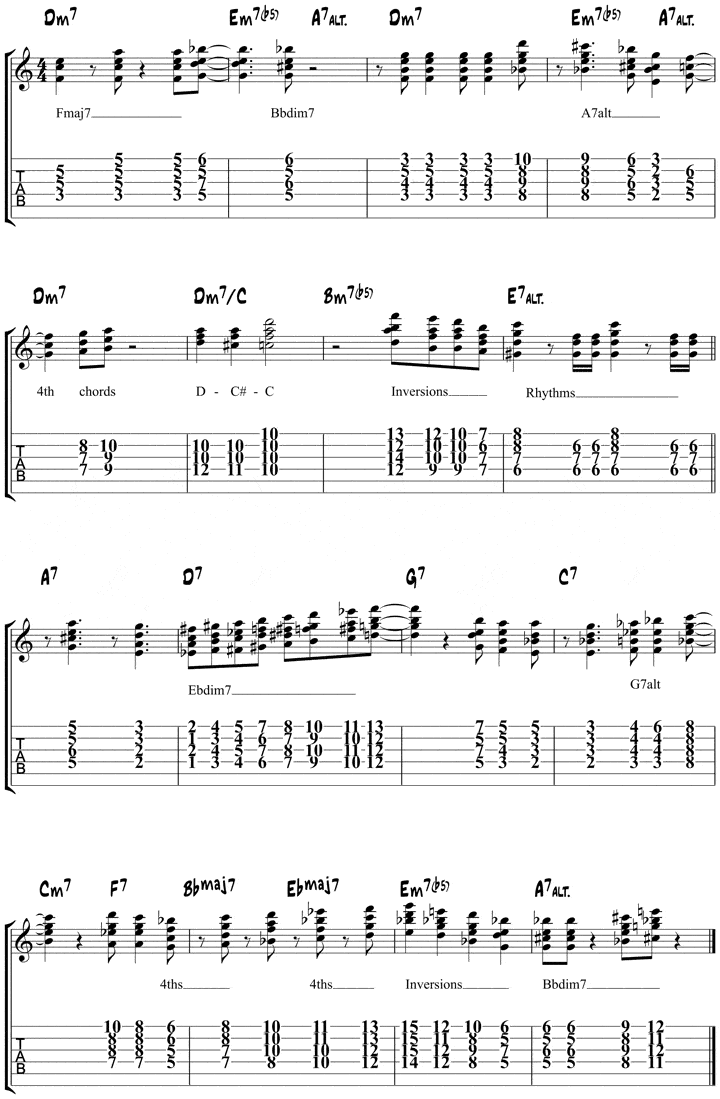Listening to Wes Montgomery play jazz can be both a liberating and intimidating experience. For a guitarist still learning the ropes of chord soloing, trying to play like Wes is daunting from the get-go. As far as chord soloing goes, Wes is known for his incredible speed, rhythm, and musical sensibility.
Using familiar shapes, most commonly drop 2 chords, Wes Montgomery played some of the greatest chord soloing lines in jazz history.
Ted Greene, the chord chemist himself, said:
“Wes Montgomery said more with the chords he played than anyone else I’ve ever heard.” – Ted Greene
Knowing how to use a few chords really well will always sound like music to your ears when compared to a long and complex chord progression played poorly.
So, what chords should you play then?
Wes himself stuck with chords played mainly on adjacent strings and drop 2 chord shapes. In this lesson, you will learn Wes Montgomery inspired chord solo licks that you’ll apply over a blues in F and over the jazz standard Yesterdays.
Wes Montgomery Chord Solo Over a Blues in F
Before playing the entire solo, let’s have a look at the chord licks and their concepts.
Lick 1 – Diminished 7 Chords
A variation of the diminished 7 lick below is found in many of Wes’ recorded chord solos. Using a single diminished 7 chord shape, you’re able to create movement, tension, lines, and interest in your chord solo.
The lick itself is based on the 4 inversions of the drop 2 diminished chord. The reason you’re using a diminished 7 chord is that it works as a substitute for the dominant 7 chord.
Playing a diminished 7 chord from the b9 of an F7 chord gives you the following chord tones:
| Gbdim7 Arpeggio | Gb | A | C | Eb |
|---|---|---|---|---|
| Played over F7 | b9 | 3 | 5 | b7 |
Because the diminished 7 chord works over any dominant 7 chord, it means that you can also play each inversion of the diminished 7 chord. It’s in the inversions of the diminished 7 chord where this lick gets really interesting.
For each inversion you play, you’ll also play a neighboring diminished 7 chord. The neighboring diminished 7 chords are always one fret away from the original inversions.
Listen & Play Along

Lick 2 – 7 Chords and min7 Chords
Playing a chord solo over a dominant 7 chord doesn’t always mean you need to play a dominant 7 chord. Certain chords work great as substitutions or passing chords. A minor 7 chord is one of these chords.
Wes Montgomery often played m7 chords in the place of dominant 7 chords, or in combination with other dominant 7 chords.
He would often build a m7 chord a 5th or a major 6th above the root of the dominant 7 chord.
Using an F7 as an example, the two m7 chords you could substitute a 5th or 6th above the root are Cm7 and Dm7. In this example lick, you will play an F7 chord in combination with a Dm7.
Listen & Play Along

Lick 3 – 9 Chords and more Diminished 7 Chords
This next lick starts out with another substitution for the dominant 7 chord.
Building a min7b5 chord on the 3rd of a dominant 7 chord gives you a dominant 9 chord.
See how the chord tones in the Am7b5 fit in relation to the F7 chord tones below.
| Am7b5 Arpeggio | A | C | Eb | G |
|---|---|---|---|---|
| Played over F7 | 3 | 5 | b7 | 9 |
Here’s the full lick:
Listen & Play Along

After outlining the F9 chord with the first 2 chords in the lick, the lick creates tension by playing two diminished 7 chords:
- The first diminished 7 chord in the lick is a V7 of V7 (or secondary dominant), being a substitute for G7b9.
- The second diminished chord is the V7 of F and is a C7b9 chord. Instead of heading right back to F7, the lick features a diminished triad built off the #9 of F (G#).
Playing a diminished triad, voiced in this particular way, gives the lick a very bluesy feel and is a key feature to understanding and emulating Wes’ chord playing.
Lick 4 – The Turnaround
The next lick is relatively large and contains all four bars of the turnaround as you’ll find them in the blues solo below.
Listen & Play Along

The first bar in this lick features an anticipated chord on the ‘and’ of 4 from the previous bar. Instead of playing a Gm7 as indicated by the blues form, you’ll play a Bbmaj7 as a substitution for Gm7.
This chord substitution is another important piece of information to remember and add to your playing.
A maj7 chord built from the b3 of the minor 7 chord gives you the following chord tones:
| Bbmaj7 Arpeggio | Bb | D | F | A |
|---|---|---|---|---|
| Played over Gm7 | b3 | 5 | b7 | 9 |
After playing the Bbmaj7 over the Gm7, you’ll play a Gm7 drop 2 chord in 3rd inversion.
From here you’ll play 2 diminished chords:
- The first diminished 7 chord in the first bar leads chromatically into the second diminished 7 chord.
- The second diminished 7 chord is actually a 7b9 substitution for the C7 chord played in anticipation of the second bar, where the C7 falls naturally in the blues form.
Once arriving at the second bar, another C7 drop 2 chord is played. This time the chord is a completely unaltered C7 Drop 2 chord in 3rd inversion.
Starting in bar 4, a I–VI–II–V progression is played using the following chords:
- The I chord is a third inversion drop 2 F7 chord (F7/Eb).
- The VI chord is a second inversion drop 2 D7 chord (D7/A).
- The II chord is a third inversion drop 2 Bmin7b5 chord used as a substitute for G7 in order to get the 9th.
- The V chord is a third inversion Bbm7b5 chord used as a substitute for C7.
Full Wes Montgomery Blues Chord Solo
After playing through each lick, work on the complete blues solo below. The solo includes all of the material covered from the previous 4 licks as well as a few new licks.
Backing Track
Listen & Play Along

Yesterdays Chord Study
In this chord study, written over the tune Yesterdays, you will learn a number of Wes chord concepts that will add that cool, Wes chord vibe to your comping, chord soloing, and chord melody playing.
Wes Montgomery Chord Study Concepts
Before you move on to learning how to play the Wes Montgomery Chord Study in this lesson, here are the concepts that were taken from Wes’ playing.
Understanding these concepts will allow you to connect a concept to the different sounds you are hearing in the study, as well as allow you to then take these concepts to other tunes.
Bars 1-4
There are a few concepts in this phrase that you can take out in order to bring a Wes vibe to your comping:
- The first is found in bar 1 of the phrase, where there is a Fmaj7 chord being used to outline a rootless Dm9 chord.
- The second concept is playing Bbdim7 over the A7alt chord in bar two, which outlines a rootless A7b9 sound.
- This leads into the Dm6 chord being used over Dm7 in bar three, with m6 being a common color in Wes’ minor comping vocabulary.
- The final concept is the use of A7alt throughout the last bar, ignoring the iim7b5 chord and playing V7alt over the entire ii-V.
Bars 5-8
In this next phrase, you will see 4th chords being used in bar one of the phrase, which are built by stacking 4th intervals rather than traditional thirds.
From there, you can hear and see the descending bassline used in bar two, which is commonly used to add movement in lines by Wes and other jazz guitarists.
The third bar features descending inversions of the Em7b5 chord, which you can slide between in order to give them that slippery Wes sound.
Lastly, the final bar has a syncopated rhythm that Wes used in his comping and chord soloing.
Bars 9-12
In the third phrase, you will see an Ebdim7 chord being used over the D7 chord in bar two.
In that same measure, each Ebdim7 chord is approached by a half-step below, which brings in that slippery, Wes sound that is characteristic of his chord soloing.
The last bar features a G7alt chord that is used over the Cm7 chord in order to set up the Cm7 chord at the start of the next bar. Playing a V7 of the next chord in the progression, over the current chord change, is something Wes loved to do. It can really add that tension-release sound to your chord lines.
Bars 13-16
The last four bars features more 4th chords, inversions, and the Bbdim7 over A7 concepts that you’ve seen before in this lesson.
Though there is nothing new in this phrase, notice how these different concepts come together to make the phrase sound cool as a whole, rather than sounding cluttered.
Wes Montgomery Chord Study (Yesterdays)
Here is the full study that you can learn in your practice routine. Don’t feel like you have to learn the whole study at once. Break it up into the four, 4-bar phrases and learn them on their own before bringing them all together.
Backing Track
Listen & Play Along




how do you put it in english :
“Bienfaiteur de l’humanité” ?
This honorific you deserve well.
…takes my hand sure enough!
Question, the use of the term “Inversion”‘ 3rd Inversion, 2nd Inversion, does this relate to the order of the notes of a drop2 chord? If not, then what is inverted?
Thx
Hi Doug! An inversion is when the root of the chord is not the lowest note of the chord voicing. For example: a Cmaj7 chord with the lowest note C (3rd fret, 5th string) is a root chord, not an inversion. A Cmaj7/E, meaning a Cmaj7 chord with E as the lowest note is the first inversion. Cmaj7/G is the second inversion and Cmaj7/B is the third inversion.
Just dug this less back up and slightly confused on lick 3:
“The second diminished chord is the V7 of F, and is a C7b9 chord”
Isn’t C7b9 = C-E-G-Bb-Db ? How does this line up with Ebdim?
Thanks
Hi Will!
The second diminished chord is on beat 2 of bar 2 and is actually an Edim7. Using Edim7 as a substitute for C7 gives you the 3, 5, b7 and b9 of the C7b9 chord (E G Bb Db). Hope that helps. Cheers!
Great lesson. it’s easy to follow and wonderful to add to a collection of players techniques. This is probably the best jazz site on the internet to learn jazz guitar and really learn it instead of memorizing licks then not knowing what to do with them. Cudos!
Do you have other material that is in this same chord lick style? That is lesson material that a student can purchase?
Hey
yes, you can find chord licks and other related material here, https://www.jazzguitar.be/blog/category/guitar-chords/, and our jazz blues intro book contains chord licks, as well as a lot of other jazz blues related material. https://www.jazzguitar.be/store/jazz-blues-guitar.php
Why are drop chords called ‘drop’? What exactly is dropped in these chords?
Hey, to build those chords you take the closed shape, R357, and you “drop” one of the notes by an octave. So for drop 2 you drop the 2nd note from the top to form the drop 2 shape, 5R37. For drop 3 chords, you drop the 3rd note from the top to form that shape, 3R57. Hope that helps.
Question about the D7b9 on lick 4. You wrote the chord symbol D7b9, but the notes are for D7. What was your intention there?
Hi Larry,
Great question! Lick 4 is based on the turn around of a standard jazz blues form. It’s most common for a jazz blues turnaround to contain a I7 – VI7b9 – iim7 – V7 progression in the last 2 bars, which is why that progression is used throughout this lesson. However, It’s not necessary to always play the same chord according to the form of the tune. You’ll notice in that same lick a Gm9 is used in bar 1, a C7b9 in bar 3 and a C9 in bar 4. When you see chords written above the staff like that, they’re meant to give you the guidelines for the harmony when soloing or comping, rather than being explicit directions (this applies when soloing over any set of changes you may find in a fake book or elsewhere). Hope that helps. Cheers!
Wow this lesson is an absolute gem
These chord comping studies are really eye opening.These etudes really continue to help my comping over jazz standards and given me lots of new ideas I hadn’t considered before.Muchas Gracias!.
Matt, thanks a lot for the lesson, all that is out of your hands, has very high quality!
Great lessons. Many tks, Matt
Absolutely a damm good and easy understanding lesson for expanding chord vocabulary and voicing !
Not having an real knowledge of guitar technique, I have to ask – Should I being practicing all of these voicings with my index finger barring? It appears this would be possible. Is it beneficial? Up to now I’ve been working on three note voicing on strings 2, 3, and 4. I haven’t been barring most of these. Perhaps I should?
Yes, I think if you can do the barre then you should, it usually makes things easier.
Is that a general rule of technique true for drop 2 and other voicings As well?
The rule I’ve found that works is “if you can play two or more notes on the same fret, different strings, then use a bar” so for any chord shape.
There is no universal rule for barre chords. The important thing is that you should use the fingering that feels the most comfortable, relaxed and puts minimal strain on your left hand. It also depends on: what comes before and after, how long does the chord last, the type of your guitar and strings, the anatomy of your hands (I have thiny fingers so cannot easily play barre chords that more fat people can), etc. .
Absolutely fantastic
this is very well done indeed. beautifully clear – and the material is just fantastic. whoever did this – and offered it to us for free – deserves a nice dinner with some pleasant conversation. thanks a lot.